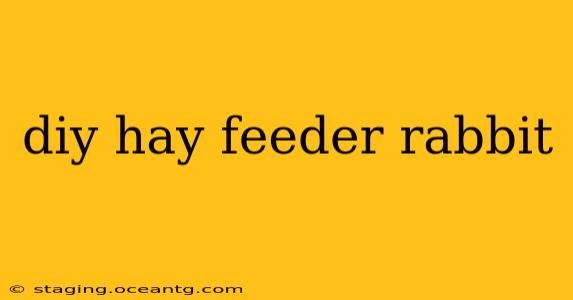Rabbits need constant access to hay, crucial for their digestive health and overall wellbeing. While commercial hay feeders are available, building your own offers cost savings and the satisfaction of crafting a customized solution perfectly suited to your bunny's needs. This guide will walk you through several DIY hay feeder designs, catering to different skill levels and budgets. We'll also address common questions surrounding rabbit hay feeders.
What are the benefits of a DIY hay feeder?
Creating your own hay feeder offers several advantages:
- Cost-effective: Building a feeder is significantly cheaper than purchasing a commercial one, especially if you already have some of the materials on hand.
- Customization: You can design a feeder that perfectly fits your rabbit's size, hutch setup, and preferences. This might include adjusting the size of the openings to prevent hay waste or designing a feeder that attaches to the hutch to save space.
- Improved Hygiene: You can easily clean and sanitize a DIY feeder, reducing the risk of bacterial buildup compared to some commercial options.
- Creative outlet: Building a feeder is a rewarding project that allows you to use your creativity and problem-solving skills.
What materials do I need to build a simple hay feeder?
The simplest hay feeder requires minimal materials and tools:
- A sturdy wire mesh: Hardware cloth or similar material is ideal; aim for a mesh size that prevents your rabbit from pulling out large clumps of hay.
- Wire cutters: To cut the wire mesh to the desired size and shape.
- Zip ties or strong wire: To secure the mesh into a suitable shape.
How to build a simple wire mesh hay feeder?
- Measure and cut: Determine the desired size and shape of your feeder. A rectangular shape is easiest. Cut the wire mesh to size, adding extra length to allow for securing the sides.
- Form the feeder: Roll the mesh into a rectangular tube, ensuring the edges overlap slightly.
- Secure the edges: Use zip ties or strong wire to securely fasten the overlapping edges. Make sure the connections are robust enough to withstand your rabbit's chewing.
- Attach to the hutch (optional): If desired, use zip ties or small screws to attach the feeder to the side of your rabbit's hutch. This prevents tipping and keeps the hay contained.
What are other DIY hay feeder options?
While a simple wire mesh feeder is a great starting point, several other options exist:
- PVC pipe feeder: Cut PVC pipes of varying diameters to create a vertical feeder. This design is great for preventing waste and is easy to clean.
- Cardboard box feeder: A repurposed cardboard box with strategically placed holes can serve as a temporary or supplemental feeder. Ensure it's rabbit-safe and replace it when it shows signs of wear.
- Wooden hay rack: A more complex option, a wooden rack can be designed with multiple levels or compartments for organized hay feeding. This requires woodworking skills and tools.
How do I prevent my rabbit from flinging hay out of the feeder?
Preventing hay waste is a common concern. Several strategies can help:
- Smaller openings: Design your feeder with appropriately sized holes to prevent your rabbit from pulling out large clumps.
- Secure attachment: Attaching the feeder to the hutch can minimize tipping and hay spillage.
- Choose the right type of hay: Hay with shorter stalks tends to be less prone to being pulled out in large amounts.
How often should I clean my DIY hay feeder?
Regular cleaning is essential for maintaining hygiene and preventing the buildup of bacteria and mold. Aim to clean your feeder at least once a week, or more frequently if necessary.
What are some safety considerations when making a DIY hay feeder?
- Sharp edges: Ensure all edges are smooth and free of sharp points that could injure your rabbit.
- Non-toxic materials: Only use materials that are safe for rabbits to come into contact with. Avoid using treated wood or materials containing harmful chemicals.
- Secure construction: Make sure the feeder is sturdy and unlikely to collapse under the weight of the hay or your rabbit's activity.
By following these guidelines, you can create a safe, efficient, and customized hay feeder for your beloved rabbit, ensuring they have constant access to this essential part of their diet. Remember to always supervise your rabbit while they are eating and regularly check their feeder for any damage or issues.
